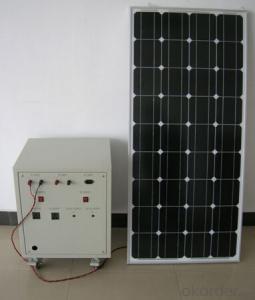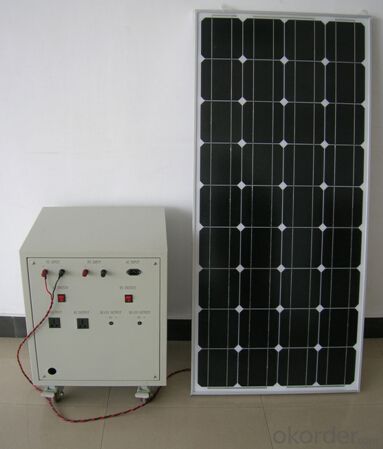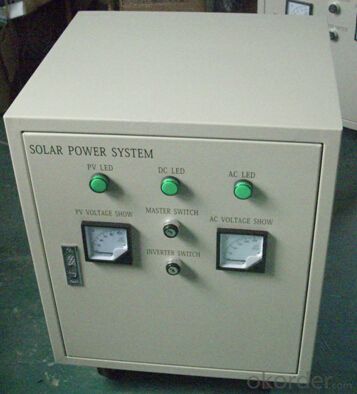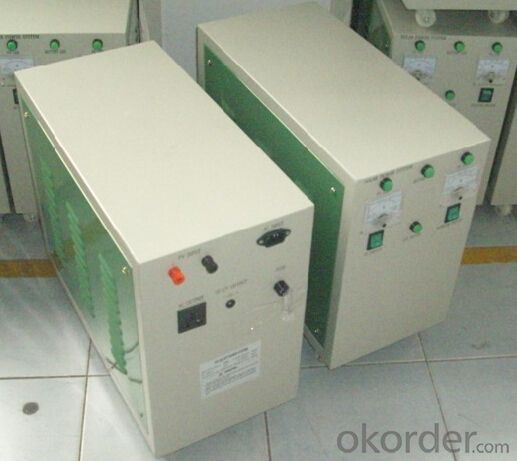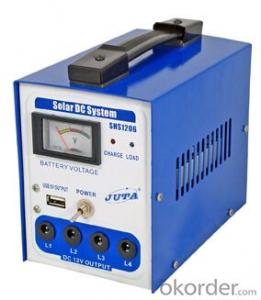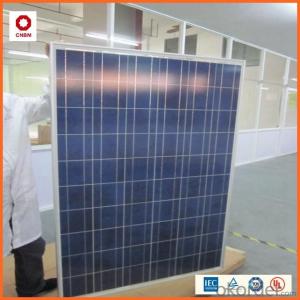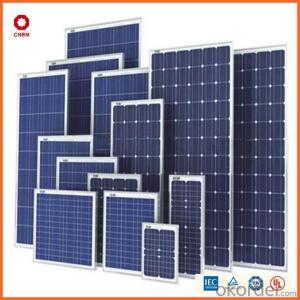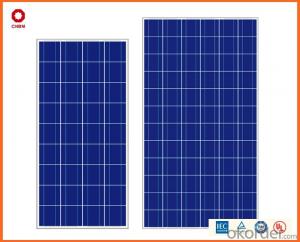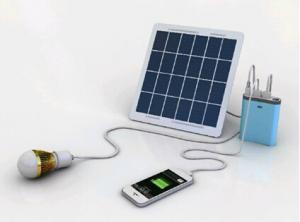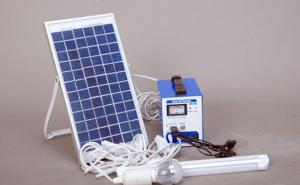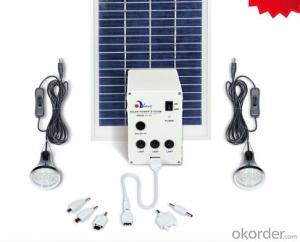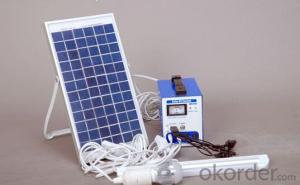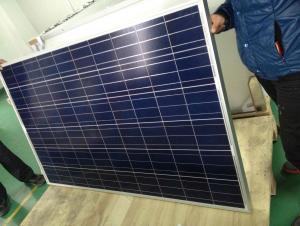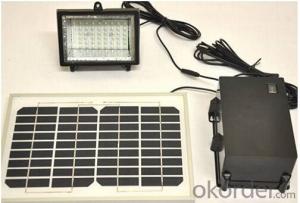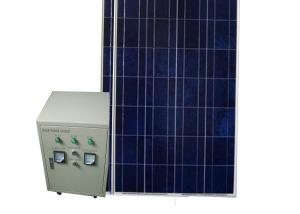Shreveport Residential Solar Energy Systems - CNBM Solar Home System Roof System Easy Installation Capacity-300W
- Loading Port:
- Shanghai
- Payment Terms:
- TT or LC
- Min Order Qty:
- 100 PCS
- Supply Capability:
- 500000 PCS/month
OKorder Service Pledge
OKorder Financial Service
You Might Also Like
Introduction of Solar Energy
In the last two decades, photovoltaics (PV), also known as solar PV, has evolved from a pure niche market of small scale applications towards becoming a mainstream electricity source. A solar cell is a device that converts light directly into electricity using the photoelectric effect. The first solar cell was constructed by Charles Fritts in the 1880s. In 1931 a German engineer, Dr Bruno Lange, developed a photo cell using silver selenide in place of copper oxide. Although the prototype selenium cells converted less than 1% of incident light into electricity, both Ernst Werner von Siemens and James Clerk Maxwell recognized the importance of this discovery. Following the work of Russell Ohl in the 1940s, researchers Gerald Pearson, Calvin Fuller and Daryl Chapin created the crystalline silicon solar cell in 1954. These early solar cells cost 286 USD/Watt and reached efficiencies of 4.5–6%. By 2012 available efficiencies exceed 20% and the maximum efficiency of research photovoltaics is over 40%.
Introduction of Solar Home System
Solar Home System is composed by Solar Panels, Inverters, Charger Controller, Battery, Cable, Mounting Bracket, which is applied to produce electricity for home use.
Solar Home System is quite suitable product in urban area and the place which is short of electricity. As the cost of solar products reduced, more and more family can bear the charge of solar products. These products apply to schools, hospitals, public halls and private housing, communication stations, weather station. Also can use as household appliances, lighting, communications equipment, meteorological equipment.
Our company’s main target is to make every family can use cheap solar energy and enjoy the new innovation of modern science and technology.
Picture of Our Factory

Working Principle of Solar Home System
This is an off-grid solar system which uses batteries to store the solar energy, at the same time, the solar system can be connected with the grid for utilization of grid power. The solar system uses battery power in priority, but when sunshine is not so good or loads consumption is too big which caused the battery power inadequacy, then the system can switch automatically to grid power supply. Meanwhile, the system can charge the batteries with grid power until batteries are fully charged. Then the solar system will switch back to battery power supply.
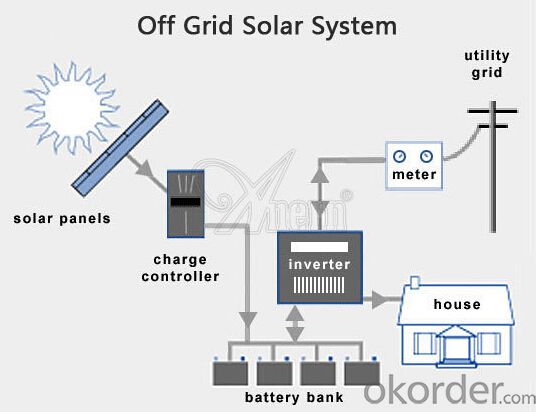
Product Details of Solar Home System
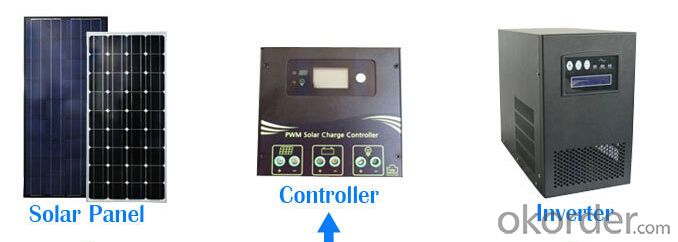
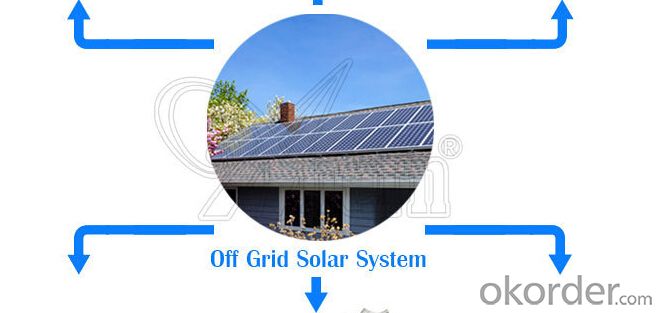

Specification of Solar Home System
Technical data: | |||||||||
Inverter | Rated load power | 1000W | |||||||
Output wave | Pure sine wave | ||||||||
Input voltage | 24V | ||||||||
Output voltage | DC:12V | ||||||||
Output frequency | 50HZ/60HZ | ||||||||
Precision of output frequency | ±6% | ||||||||
Solar panel | Pmax | 150W*2PCS | |||||||
Vmp | 36V | ||||||||
Imp | 8.34A | ||||||||
Charger | Charger voltage & current | 24V/20A | |||||||
Battery | Capacity | 12V100AH*2PCS | |||||||
Power box | Spray paint iron box,with input,output, ammeter,voltmeter,master switch and so on. | ||||||||
Package data: | |||||||||
Part | Size (L*W*H mm) | Weight (kg) | 20' (pcs) | 40' (pcs) | |||||
Power box | 580*520*540 | 60 | 84Sets | 200Sets | |||||
Solar panel | 1500*700*90 | 24 | |||||||
Solar panel bracket |
|
| |||||||
Loading electrical equipment(For consult) | |||||||||
Name of Load | Power(W) | Quantity | Working Time per Day (H) | Working Days | |||||
Color TV | 65W | 1 | 6 | 3 days | |||||
Satellite TV Receivers | 25W | 1 | 6 | 3 days | |||||
lamp | 11W | 2 | 8 | 3 days | |||||
Other | 150W |
| 2 | 3 days | |||||
Advantage of Our Solar Home System
1 Excellent Performance: Our Solar Home System is composed by Brand Standard Kits with high quality. Our solar system has the advantage of high efficiency and stable operation. We can ensure our product with a long life period.
2. Small Orders Accepted: We can accept small orders as our customer’s trial order.
3. Guarantee/Warranty: We supply 10 Years Product Warranty and 25 Years Performance warranty.
4. Warehouse: We have warehouse overseas which can bring great convenience to our customer to pick up the products.
FAQ
Q: You are a manufacturer or Trader?
A: We are a Group corp. with 1GW capacity, which is Okorder’s registered VIP Supplier, enjoy Okorder’s Financial Guarantee.
Q: Required mainly certificates (CE&IEC/TUV/RoHS)?
A: Our products are certificated by CE RoHS, IEC, C-tick etc.
Q: Your main exported market is?
A: Main markets of our products is: South-east Asia, Mid-east, Arica, East Europe and Latin America.
- Q: Can solar energy systems be used in areas with high levels of natural disasters?
- Yes, solar energy systems can be used in areas with high levels of natural disasters. Solar panels are designed to withstand various weather conditions, including hurricanes, earthquakes, and extreme temperatures. Additionally, solar energy systems are decentralized and can operate independently of the grid, providing a reliable source of electricity during power outages caused by natural disasters. Therefore, solar energy systems can be a valuable and resilient solution for generating clean energy in disaster-prone areas.
- Q: Are there any risks of electrical arcing with solar energy systems?
- Yes, there are risks of electrical arcing with solar energy systems. Electrical arcing can occur due to various factors such as faulty wiring, loose connections, or damaged components. This can lead to fires, damage to the system, and potential harm to individuals nearby. Therefore, proper installation, regular maintenance, and adherence to safety guidelines are crucial to minimize the risks of electrical arcing in solar energy systems.
- Q: Can solar energy systems be used for powering off-grid educational institutions?
- Yes, solar energy systems can indeed be used for powering off-grid educational institutions. Solar panels can be installed on the rooftops of buildings to harness the sun's energy and convert it into electricity. This renewable energy source can then be used to power various electrical appliances, lighting, and other necessities within the educational institution. By utilizing solar power, off-grid educational institutions can reduce their dependence on traditional energy sources and contribute to a more sustainable and environmentally friendly way of generating electricity.
- Q: How do solar energy systems impact job training and skill development?
- Solar energy systems have a positive impact on job training and skill development. As the demand for renewable energy continues to rise, the installation, maintenance, and operation of solar panels require specialized skills. This creates opportunities for job training programs and vocational schools to offer courses and certifications specifically tailored to the solar energy industry. Consequently, individuals can acquire valuable skills, such as solar panel installation, electrical engineering, and project management, which not only enhance their employability but also contribute to the growth of the clean energy sector. Overall, solar energy systems play a crucial role in expanding job training initiatives and skill development in the renewable energy field.
- Q: Can solar energy systems be used for greenhouse heating?
- Yes, solar energy systems can be used for greenhouse heating. Solar panels can be installed to convert sunlight into electricity, which can then be used to power heating systems within the greenhouse. Additionally, solar thermal systems can be used to directly heat water or air within the greenhouse. These systems provide a sustainable and cost-effective solution for greenhouse heating, reducing reliance on fossil fuels and minimizing environmental impact.
- Q: Do solar energy systems work during cloudy days?
- Yes, solar energy systems can still work during cloudy days, although their efficiency may be reduced. While direct sunlight is the most effective way to generate electricity from solar panels, they can still produce power even with indirect or diffused sunlight. Cloudy days typically diminish the amount of sunlight reaching the panels, resulting in lower energy production. However, advancements in solar technology, such as the use of more efficient panels and improved light absorption, have made it possible for solar energy systems to generate electricity even in less ideal weather conditions. Additionally, solar systems are designed to capture and store excess energy during sunny periods, which can be utilized during cloudy days or at night.
- Q: How do solar energy systems impact the quality of indoor air?
- Solar energy systems have a positive impact on the quality of indoor air. By harnessing the sun's energy, solar systems eliminate the need for fossil fuel-based energy sources, thus reducing the emission of harmful pollutants such as carbon dioxide, sulfur dioxide, and nitrogen oxides. This reduction in emissions leads to cleaner air indoors, promoting better health and reducing the risk of respiratory problems for occupants.
- Q: Can a solar energy system be installed in areas with heavy snowfall?
- Yes, a solar energy system can be installed in areas with heavy snowfall. While heavy snowfall can affect the efficiency of solar panels, proper design and installation can ensure their effectiveness even in snowy conditions. Here are a few considerations: 1. Tilt and angle: Solar panels are typically installed at an angle to maximize exposure to sunlight. In areas with heavy snowfall, panels can be tilted at a steeper angle, allowing the snow to slide off more easily. 2. Snow clearing: Regular snow clearing can help maintain the performance of solar panels. This can be done manually or through automated systems that use brushes or heating elements to melt the snow. 3. Orientation: Orienting the solar panels towards the south or where they receive maximum sunlight can help mitigate the impact of heavy snowfall. This ensures that when the snow melts, the panels can quickly resume their normal operation. 4. Adequate spacing: Providing sufficient spacing between solar panels can prevent snow accumulation from one panel affecting the entire system. This allows for continued energy production even if some panels are temporarily covered in snow. 5. System monitoring: Installing a monitoring system can help identify any issues with snow accumulation or reduced energy production. This allows for timely intervention and maintenance to ensure optimum performance. While heavy snowfall may temporarily reduce energy production, a well-designed solar energy system can still be a viable option in areas with these weather conditions. It is important to consult with experienced solar installers who can design and install a system that can withstand and adapt to heavy snowfall.
- Q: Are there any risks of electrical hazards during installation or maintenance of solar energy systems?
- Yes, there are risks of electrical hazards during the installation or maintenance of solar energy systems. Solar energy systems involve working with high-voltage DC (direct current) electricity, which can pose dangers if not handled properly. Some of the potential risks include: 1. Electrocution: Solar panels generate electricity, and if not isolated or disconnected properly, there is a risk of electrocution for individuals working on the system. 2. Fire Hazards: Faulty wiring, loose connections, or improper installation can lead to electrical arcs and sparks, which can ignite a fire if proper precautions are not taken. 3. Falls and Injuries: Solar panels are typically installed on rooftops, which may involve climbing ladders, working at heights, and handling heavy equipment. If not done with caution, it can result in slips, falls, or injuries. 4. Arc Flash: When working on live electrical equipment, there is a risk of arc flash, which is a sudden release of energy that can cause severe burns, hearing damage, and even death. 5. Environmental Risks: While not directly related to electrical hazards, it is essential to consider potential environmental risks during the installation of solar energy systems. For instance, improper disposal of hazardous materials used in solar panels, such as lead, cadmium, or other toxic substances, can harm the environment if not handled correctly. To mitigate these risks, it is crucial to follow proper safety protocols and guidelines during the installation and maintenance of solar energy systems. This includes wearing personal protective equipment (PPE), ensuring proper grounding and isolation procedures, using insulated tools, and following all local electrical codes and regulations. It is also recommended to hire trained and certified professionals for the installation and maintenance to minimize the risks associated with electrical hazards.
- Q: How do solar energy systems impact the overall sustainability of a home?
- Solar energy systems have a significant positive impact on the overall sustainability of a home. By harnessing the power of the sun, these systems generate clean and renewable energy, reducing reliance on fossil fuels and decreasing greenhouse gas emissions. Solar panels promote energy efficiency, helping to lower electricity bills and save money in the long run. Additionally, solar energy systems contribute to the resilience of a home, enabling homeowners to be less dependent on the grid during power outages. Overall, solar energy systems play a vital role in enhancing the sustainability and environmental footprint of a home.
Send your message to us
Shreveport Residential Solar Energy Systems - CNBM Solar Home System Roof System Easy Installation Capacity-300W
- Loading Port:
- Shanghai
- Payment Terms:
- TT or LC
- Min Order Qty:
- 100 PCS
- Supply Capability:
- 500000 PCS/month
OKorder Service Pledge
OKorder Financial Service
Similar products
Hot products
Hot Searches
Related keywords
